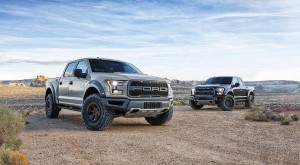
The new Ford F-150 Raptor SuperCrew gets more room for adults and gear as well as improved performance and technology.
What’s better than a Ford F-150 Raptor? A bigger one!
Ford introduced its new F-150 Raptor SuperCrew model during the North American International Auto Show. The new model features more passenger room and, perhaps more importantly, more power courtesy of a newly hopped up 3.5-liter EcoBoost V6.
The result is the most capable Raptor ever, Ford says. The new EcoBoost replaces the 6.2-liter V8 and is mated to a new 10-speed transmission. Specific figures are not yet available, but it surpasses the 411 horsepower and 434 ft-lb of torque of the V8 it replaces.
That additional power is paired with additional room. Raptor SuperCrew boasts four full-size doors giving rear passengers with more legroom and comfort on the trails and more space to stow gear. SuperCrew’s 145-inch wheelbase is 12 inches longer than the standard Raptor SuperCab 133-inch wheelbase.
“F-150 Raptor means superior off-road capability, from rock crawling to sand running,” said Dave Pericak, Ford Performance global director, in a release. “With the addition of SuperCrew, F-150 Raptor customers can leave the pavement behind – without sacrificing comfort and space.”
(Honda Civic, Volvo XC90 land North American Car, Truck/Utility of the Year. For more, Click Here.)
Offering a newer, more powerful version comes as the full-size truck segment is becoming a tougher battleground with the introduction of revamped offerings from Nissan and Toyota as well as General Motors.
The specialized truck market is also beginning to see new players. Nissan offered a Nissan Titan Warrior concept that reveals a potential competitor to the Raptor with similar power and capability. However, for now, the Warrior is a concept, but the success of Raptor clearly is defining a new segment that others will soon play.
An all-new four-wheel-drive, torque-on-demand transfer case, with advanced, easy-to-use off-road mode driver-assist technology, further improves Raptor’s performance so it is easy to drive off-road across different types of terrain.
(Click Here for details about makers shifting production from sedans to SUVs and trucks.)
The new transfer case, which manages power distribution between the front and rear wheels, combines the best attributes of clutch-driven, on-demand all-wheel drive with durable, mechanical-locking four-wheel drive to send power to the wheels in slippery conditions.
Ford has taken the Raptor’s new off-road driving mode technology and developed an all-new Terrain Management System that enables the driver to select modes to optimize driving dynamics to environmental conditions – from snow to mud, sand and more.
The system offers six preset modes for different terrain and driving conditions:
- Normal mode for everyday driving
- Street mode for higher-performance, on-road driving
- Weather mode for rain, snow or ice
- Mud and sand mode for muddy and sandy trails and terrain
- Baja mode for high-speed desert running and
- Rock mode for low-speed rock crawling
Not only is the Raptor using advanced technology, it also uses advanced materials like high-strength steel and high-strength, military grade, aluminum alloy.
Using the materials help save up to 500 pounds on the new truck and improves the truck’s off-road prowess. Combined with all-new EcoBoost engine technology, the next-generation F-150 Raptor’s power-to-weight ratio has been improved, making the truck even more agile off-road, Ford claims.
An available Torsen front differential increases off-road capability further. The system increases grip significantly for the front end of the truck and allows it to pull itself over obstacles and up steep grades – even when traction is split between the front tires.
F-150 Raptor comes standard with new FOX Racing Shox with custom internal bypass technology that works to damp and stiffen suspension travel over rough terrain, helping prevent the truck from bottoming out.
(To see more about the Nissan Titan Warrior concept, Click Here.)
Front and rear shock canisters have grown from 2.5 inches to 3 inches in diameter for improved performance. They feature more suspension travel than the current Raptor’s 11.2 inches at the front and 12 inches at the rear.


